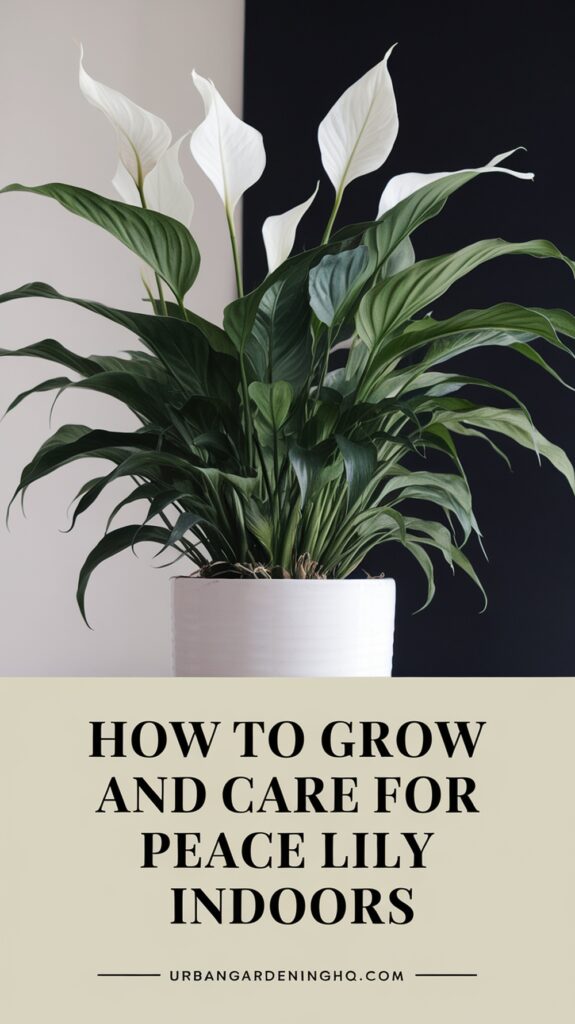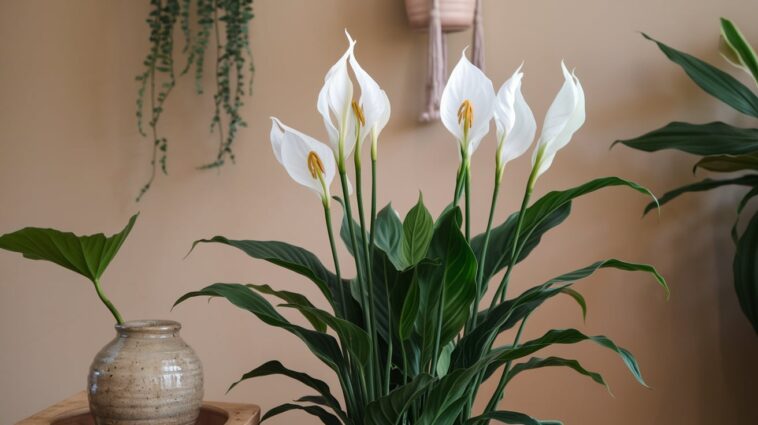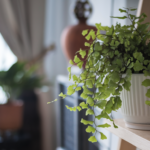I’m excited to share my knowledge on caring for your peace lily plant. It’s a favorite among indoor plants. With the right care, your peace lily will bloom beautifully and purify the air, making your home even nicer.
Peace lilies are easy to care for, but they need some attention. In this guide, I’ll cover everything you need to know. Topics include lighting, watering, fertilizing, and pruning. This way, you can enjoy the many benefits of having peace lilies at home.
Understanding Your Peace Lily Plant

To care for your peace lily, knowing its background and traits is key. Peace lilies belong to the Arum family and come from tropical Americas and Southeast Asia. This info helps you create a home-like environment for your plant.
There are many peace lily varieties, each with its own look and growth pattern. Knowing your plant’s specific needs is important for its health and beauty. Tailor your care to match your peace lily’s unique traits.
Scientific Name and Origins
The scientific name for the peace lily is Spathiphyllum wallisii. It thrives in humid, light-filtered environments. This knowledge helps you understand its light and water needs.
Different Peace Lily Varieties
Popular varieties include ‘Mauna Loa’ and ‘Sensation’. Each has its own leaf size and flower color. Pick a variety that fits your space and care skills for a beautiful peace lily.
Natural Habitat Characteristics
In the wild, peace lilies grow on the forest floor. They get dappled light and steady moisture. Mimicking these conditions with proper care and tips will make your plant thrive.
By understanding and mimicking your peace lily’s natural habitat, you create the perfect environment. This, along with the right variety and care tips, makes you a great peace lily caregiver.
| Peace Lily Variety | Characteristics | Gardening Tips |
|---|---|---|
| ‘Mauna Loa’ | Large leaves, white blooms | Provide bright, indirect light; water thoroughly |
| ‘Sensation’ | Compact growth, fragrant flowers | Maintain high humidity; fertilize regularly |
Why I Love Growing Peace Lilies Indoors

I’ve always loved indoor plants, and peace lilies are my top pick. They’re great for homes because they need little care and can handle different light levels. This makes them perfect for those who are busy or new to gardening. Their elegant white flowers and dark green leaves bring beauty to any room.
What I love most about peace lilies is how easy they are to care for. They can thrive with minimal attention, making them ideal for those who want low-maintenance plants. Some benefits of having peace lilies indoors include:
- They help purify the air and improve indoor air quality
- They add natural beauty to any room
- They’re small and fit well in small spaces, great for apartments or offices
As someone who loves indoor plants, I can say peace lilies are a top choice. They’re easy to care for, beautiful, and improve air quality. Whether you’re experienced or new to gardening, peace lilies are a great pick for indoor plants.
Essential Light Requirements for Healthy Growth
Understanding your indoor plants’ lighting needs is key for their health. Peace lilies, for example, do well in well-draining soil and bright, indirect light. They can also handle low light, making them perfect for dimly lit rooms.
To keep your peace lily happy, watch its light exposure and adjust as needed. Here are some helpful tips:
- Position your peace lily near an east- or west-facing window for bright, indirect light.
- Steer clear of direct sunlight to prevent leaf scorching.
- Use grow lights in low-light rooms to meet your peace lily’s needs.
By following these guidelines, you can ensure your peace lily gets the right light. This is vital for its growth and blooming. Remember, proper care is essential for your plants’ well-being.
| Lighting Condition | Effect on Peace Lily |
|---|---|
| Bright Indirect Light | Promotes healthy growth and blooming |
| Low Light | Can tolerate, but may not bloom as frequently |
| Direct Sunlight | Can cause leaves to become scorched |
Mastering Peace Lily Watering Techniques
As a houseplant lover, I’ve learned that watering is key for my peace lilies’ health. Knowing what your plants need is important. For peace lilies, checking the soil moisture is a must.
Watering only when the soil is dry is best. This stops overwatering, which can harm the roots. Also, don’t water the leaves or crown to avoid rot. These tips help your peace lily get the right moisture.
Here are some more tips for watering your peace lily well:
- Water your peace lily in the morning to allow the plant to absorb the water throughout the day
- Use room-temperature water to prevent shocking the roots
- Avoid getting water on the leaves or crown to prevent rot and other issues
Mastering peace lily watering helps your plants thrive. Keep an eye on the soil moisture and adjust your watering as needed. With the right care and watering, your peace lily will bring beauty and benefits for years.
| Watering Tips | Benefits |
|---|---|
| Water in the morning | Allows plant to absorb water throughout the day |
| Use room-temperature water | Prevents shocking the roots |
| Avoid getting water on leaves or crown | Prevents rot and other issues |
Soil and Potting Requirements
To keep my peace lily happy, I focus on the right soil and potting. I create a soil mix that drains well and is rich in organic matter. This mix includes peat moss, perlite, and vermiculite, helping the roots breathe and absorb nutrients.
Choosing the right pot is also key. I pick one that’s a bit bigger than the plant’s roots and has drainage holes. This keeps the soil healthy and prevents root rot. By doing this, I give my peace lily the best care.
Key Considerations for Soil Mixtures and Potting
- Use a well-draining soil mixture to prevent waterlogged soil
- Choose a pot that is slightly larger than the plant’s root system
- Ensure the pot has good drainage holes to prevent root rot
- Repot your peace lily every 1-2 years to provide fresh soil and a larger pot if necessary
By following these tips, I ensure my peace lily gets the best care. This leads to healthy growth and beautiful blooms.
Temperature and Humidity Needs
As a peace lily owner, I’ve learned that keeping the right temperature and humidity is key. Peace lilies do best in temperatures between 65-80°F (18-27°C). They also like humidity levels between 40-60%. I use a thermometer and hygrometer to check these conditions in my home.
It’s important to avoid extreme temperatures for your plant. I keep my peace lily away from heating vents, fireplaces, or drafty windows. This helps keep the temperature stable, which is good for growth. Also, the right humidity level is important to prevent problems like brown tips and edges. For more tips on plant care, check out urban gardening resources.
Some key things to remember about temperature and humidity include:
- Keep the temperature between 65-80°F (18-27°C) steady.
- Humidity should be between 40-60%.
- Avoid big changes in temperature and humidity.
By following these tips and keeping an eye on temperature and humidity, I can give my peace lily the best conditions. This is important for its growth and blooming, which are key parts of caring for it.
Fertilizing Your Peace Lily for Maximum Blooms
Fertilizing is key for healthy growth and blooms in plants like peace lilies. Use a balanced, water-soluble fertilizer made for indoor plants. This helps your peace lily thrive.
The right fertilizer is important. Choose a general-purpose or a high-phosphorus fertilizer for blooms. Here are some good choices:
- 20-20-20 balanced fertilizer
- 15-30-15 bloom booster fertilizer
- Organic fertilizers like fish emulsion or compost tea
Fertilize your peace lily in the growing season with a phosphorus-rich fertilizer. Always follow the package instructions. Avoid overfertilizing to prevent root damage. With these tips, your peace lily will bloom beautifully.
Pruning and Maintenance Tips
As a peace lily owner, I know how important pruning and maintenance are. They keep my plant healthy and looking great. Regular pruning stops disease and encourages new growth, which is vital for care.
To keep my peace lily thriving, I remove dead or dying leaves or flowers. This keeps the plant looking good and stops disease. I also dust the leaves often to avoid pests and keep humidity levels right, which is key for maintenance.
Here are some tips for pruning and maintenance:
- Check your peace lily often for pests or diseases and act fast if you see any.
- Use clean, sharp tools when pruning to avoid spreading disease.
- Prune your peace lily in the spring and summer when it’s growing.
By following these tips and making pruning and maintenance part of my routine, my peace lily stays healthy and blooms. Remember, regular care is essential for your peace lily to keep blooming and growing.
Troubleshooting Common Peace Lily Problems

As a peace lily owner, I’ve faced many plant problems. It’s key to spot and fix these issues fast. Knowing how to tackle common problems helps prevent and manage pests and other issues.
Yellowing leaves, brown tips, and pests are common issues. Understanding why they happen helps you act quickly. For instance, yellow leaves often mean too much water. Brown tips and edges can come from too little water or extreme temperatures.
Common Issues and Solutions
- Yellowing leaves: Check your watering schedule and adjust as needed to prevent overwatering.
- Brown tips and edges: Ensure your peace lily is receiving the right amount of water and humidity.
- Pest management: Regularly inspect your plant for signs of pests, such as spider mites or mealybugs, and take action promptly if you notice any issues.
- Disease prevention: Keep your peace lily in a well-ventilated area and avoid overwatering to prevent fungal diseases.
By following these tips and being proactive, you can keep your peace lily healthy. Always watch for problems and fix them quickly to avoid bigger issues.
Propagation Methods Made Simple
Exploring peace lily propagation has been a fun journey. It’s rewarding to share my peace lily with loved ones. Division is a common method, where you separate the roots and replant them. This needs some gardening tips and patience, but it’s worth it.
Leaf cuttings or seed propagation also work well. These methods take more time but can be just as successful as division. For success, you need the right soil, water, and light. Following these tips helps me enjoy the fruits of my labor and share my knowledge.
Some key considerations for propagation include:
- Choosing healthy sections of the plant for division or leaf cuttings
- Providing the right conditions for plant care, including soil, water, and light
- Being patient and allowing the new plants to establish themselves
By following these tips and using the right techniques, anyone can master the art of peace lily propagation. It offers many benefits.
Conclusion: Growing a Thriving Peace Lily
Growing a thriving peace lily needs careful attention to its needs. This includes the right lighting, watering, fertilizing, and pruning. By following the tips in this guide, you can give your peace lily the best care.
A well-cared-for peace lily adds beauty and calm to any room. It brings joy and a sense of accomplishment to gardeners. Its elegant white blooms and lush green leaves are a sight to behold.
Peace lilies are great for both experienced and new gardeners. They are easy to care for and can make your home greener. With the right care, your peace lily will bloom beautifully and purify the air. Enjoy the process of caring for your peace lily and watch your home become a lush oasis.


